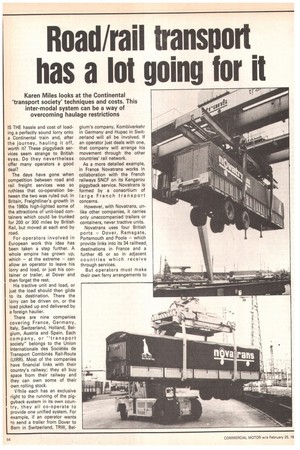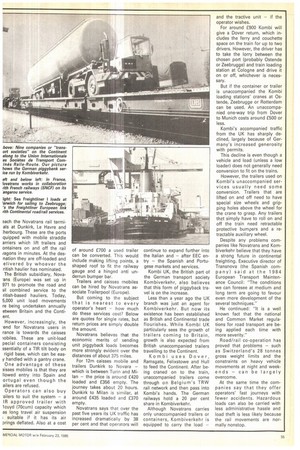Road/rail transport has a lot going for it
Page 56

Page 57

If you've noticed an error in this article please click here to report it so we can fix it.
Karen Miles looks at the Continental 'transport society' techniques and costs. This inter-modal system can be a way of overcoming haulage restrictions
IS THE hassle and cost of loading a perfectly sound lorry onto a Continental train and, after the journey, hauling it off, worth it? These piggyback services seem strange to British eyes. Do they nevertheless offer many operators a good deal?
The days have gone when competition between road and rail freight services was so ruthless that co-operation between the two was ruled out. In Britain, Freightliner's growth in the 1980s high-lighted some of the attractions of unit-load containers which could be trunked for 200 or 300 miles by British Rail, but moved at each end by road.
For operators involved in European work this idea has been taken a step further. A whole empire has grown up, which — at the extreme — can allow an operator to leave his lorry and load, or just his container or trailer, at Dover and then forget the rest.
His tractive unit and load, or just the load should then glide to its destination. There the orry can be driven on, or the load picked up and delivered by a foreign haulier.
There are nine companies covering France, Germany, Italy, Switzerland, Holland, Belgium, Austria and Spain. Each company, or "transport society" belongs to the Union Internationale des Societes de Transport Combines Rail-Route (UIRRi. Most of the companies have financial links with their country's railway; they all buy space from their railway and they can own some of their own rolling stock.
11-thile each has an exclusive right to the running of the piggyback system in its own country, they all co-operate to provide one unified system. For example, if an operator wants to send a trailer from Dover to Bern in Switzerland, TRW, Bel gium's company, Kombiverkehr in Germany and Hupac in Switzerland will all be involved. If an operator just deals with one, that company will arrange his movement through the other countries' rail network.
As a more detailed example, in France Novatrans works in collaboration with the French railways SNCF on its Kangarou piggyback service. Novatrans is formed by a consortium of large French transport concerns.
However, with Novatrans, unlike other companies, it carries only unaccompanied trailers or containers, never tractive units.
Novatrans uses four British ports — Dover, Ramsgate, Portsmouth and Poole — which provide links into its 34 railhead, destinations in France and a further 45 or so in adjacent countries which receive through services.
But operators must make their own ferry arrangements to Bach the Novatrans rail termials at Dunkirk, Le Havre and lherbourg. These are the ports quipped with mobile straddle arriers which lift trailers and ontainers on and off the rail iagons in minutes. At the desnation they are off-loaded and elivered by whoever the ritish haulier has nominated. The British subsidiary, Nova
ans (Europe) was set up in 971 to promote the road and 3i1 combined service to the ritish-based hauliers. Today, 5,000 unit load movements re being undertaken annually etween Britain and the Contient.
However, increasingly, the .end for Novatrans users in rance is towards the caisses iobiles. These are unit-load pecial containers consisting ssentially of a TIR tilt body on rigid base, which can be easy handled with a gantry crane. One advantage of these aisses mobiles is that they are Ilowed entry into Spain and ortugal even though the ailers are refused.
Operators can also buy ailers to suit the system — a IR approved trailer with 1cuyd (70cum) capacity which as long travel air suspension suitable if it has its air orings deflated. Also at a cost of around E700 a used trailer can be converted. This would include making lifting points, a shaped roof to fit the railway gauge and a hinged anti underrun bumper bar.
Trailers and caisses mobiles can be hired by Novatrans associate Trailerpool (Europe).
But coming to the subject that is nearest to every operator's heart how much do these services cost? Below are quotes for single rates, but return prices are simply double the amount.
Novatrans believes that the economic merits of sending unit piggyback loads becomes more strongly evident over the distances of about 375 miles.
For 12m caisses mobile and trailers Dunkirk to Novara — which is between Turin and Milan — the price is around £420 loaded and £356 empty. The journey takes about 20 hours. Dunkirk to Milan is similar, at around £435 loaded and £370 empty.
Novatrans says that over the past five years its UK traffic has increased dramatically by 38 per cent and that operators will continue to expand further into the Italian and — after EEC entry — the Spanish and Portugese markets and services.
Kombi UK, the British part oi the German transport society Kombiverkehr, also believes that this form of piggyback travel is on the increase.
Less than a year ago the UK branch was just an agent for Kombiverkehr. But now its existence has been established as British and Continental trade flourishes. While Kombi UK particularly sees the growth oi trailers coming to Britain, growth is also expected from British unaccompanied trailers travelling to the Continent.
Kombi uses Dover, Ramsgate, Felixstowe and Hull to feed the Continent. After being craned on to the train, unaccompanied trailers come through on Belgium's TRW rail network and then pass into Kombi's hands. The German railways hold a 20 per cent share in Kombiverkehr.
Although Novatrans carries only unaccompanied trailers or containers, Kombiverkehr is equipped to carry the load and the tractive unit — if the operator wishes.
For around £900 Kombi will give a Dover return, which includes the ferry and couchette space on the train for up to two drivers. However, the driver has to take the lorry between the chosen port (probably Ostende or Zeebrugge) and train loading station at Cologne and drive it on or off, whichever is necessary.
But if the container or trailer is unaccompanied the Kombi loading stations' cranes at Ostender Zeebrugge or Rotterdam can be used. An unaccompanied one-way trip from Dover to Munich costs around £500 or less.
Kombi's accompanied traffic from the UK has sharply declined, largely because of Germany's increased generosity with permits.
This decline is even though a vehicle and load (unless a low loader) does not generally need conversion to fit on the trains.
However, the trailers used on Kombi's unaccompanied services usually need some conversion. Trailers that are lifted on and off need to have special size wheels and gripping holes above the wheel for the crane to grasp. Any trailers that simply have to roll on and off the train need retractable protective bumpers and a retractable auxiliary wheel.
Despite any problems companies like Novatrans and Kombiverkehr believe that they have a strong future in continental freighting. Executive director of Transnova (the Spanish company) said at the 1984 European Transport Maintenance Council: "The conditions we can foresee at medium and long term are going to favour even more development of the several techniques."
He continued: "It is a well known fact that the national and Common Market regulations for road transport are being applied each time with more severity."
Road/rail co-operation has proved that problems — such as Switzerland's 28 tonnes gross weight limits and the constraints on heavy vehicle movements at night and weekends — can be largely overcome.
At the same time the companies say that they offer operators' fast journeys with fewer accidents. Hazardous loads can also be carried with less administrative hassle and load theft is less likely because the rail movements are normally nonstop.




















































































